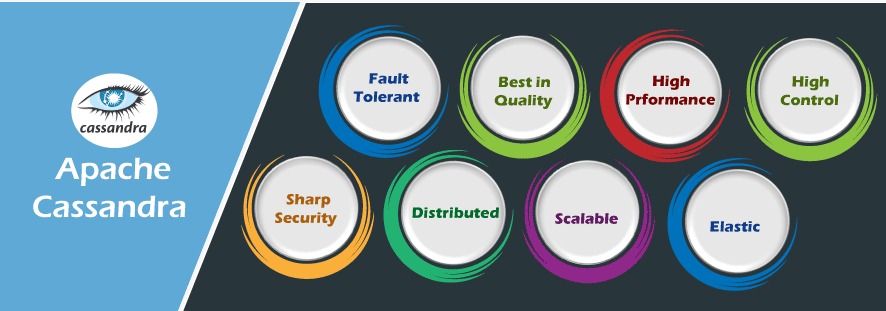Features of Cassandra
Features of Cassandra: Apache Cassandra is a distributed NoSQL database management system. Mostly deals with high amount of data stored across various machines. The large scale data is handled with the help of the architecture.

Following are the features of Cassandra:
Hybrid:
- Cassandra architecture is very robust.
- At the same time it is very flexible.
- It has very low latency as data is stored over many nodes.
- An entire data centre of any means can handle with no single data loss.
- It can perform across public and private clouds with no major difference.
Fault Tolerant:
- It has huge amount of data to deal with.
- The data is stored over various machines/ data-centre’s.
- On the first hand it is best-in-class regarding storage of data due its architecture.
- On the other hand it maintains those data with low latency rate.
- It also handles the node fails, regional outages.
Best in Quality:
- It is tested through many criteria’s.
- One such test is over 1000 node with grouped clusters.
- Implementing those clusters on various real world scenarios.
- It was tested over fuzzy logics, property related schemas, performance tests.
- This proves that Cassandra is very stable and reliable as per the terms of huge data.
High Performance:
- Cassandra has always been scored high benchmarks.
- It can deal with various alternatives of Nosql.
- The benchmarks had been out-performing even on various real world scenarios.
- This is because of the architecture primarily supporting fundamental needs.
High Control:
- As per the requirement one could choose as many nodes as required.
- The more the number of nodes more robust and fast accessing of data can happen.
- The data could be synchronous or asynchronous replica on to other nodes.
- Cassandra also supports features which enhance and optimize the performance of asynchronous data.
- Some of those features are hinted handoff and read repair.
Sharp Security:
- Cassandra provides wide amount security across several data centre’s and machines.
- DDL, DML, DCL operations are tracked by an audit logging feature.
- It will make sure that the operations do not impact the performance on the word load.
- The replaying and capturing of workloads is monitored by a feature called fqltool.
- It also calculates the work load analysis.
Distributed:
- Most of the firms in today’s time cannot afford to lose data.
- Especially if the data is stored across various data-centre’s.
- Cassandra is suitable for such firms.
- It doesn’t lose the data even if an entire data-centre is down.
- The replica of data can be easily processed by nodes by gossip method.
- Yet there is no master node, which keeps track of other nodes processing.
- Bottleneck network are absent in Cassandra.
- All the nodes in a single cluster are similar/ identical.
Scalable:
- Huge amount of data can be replicated over the clusters to every node.
- Operations such as read and write are applied on to the data.
- A node reads the data and writes into the memory.
- The throughput of read and write operations will be drastically increased in a linear fashion as new machines will be added.
- When a new machine is added, there would not be any interruption to the applications.
Elastic:
- Cassandra reads through nodes during scaling operations.
- Scaling operations such as new node adding, data centre adding during peak traffic situations.
- Use of copy streaming makes the streaming 5x times faster without virtual-nodes for more flexible architecture.
- Especially used in cloud technologies and kubernetes.
Cassandra Query Language:
- Cassandra Query Language viz, CQL.
- Cassandra Query Language is closely similar to SQL i.e, in primary terms both languages have tables dealing with rows and columns.
- Therefore, the relational database developers can easily switch to Cassandra.
- It is a simple interface to access Cassandra.
- Cassandra is a hybrid of tabular-DBMS and key-value.
- It has following operations,
- data types operations
- definitions operations
- data definitions operations
- data manipulation operations
- Secondary indexes operations
- Security operations
- Arithmetic operations
- JSON support operations
- Triggers operations
Summary:
- The features of Cassandra are vast and powerful.
- It’s features majorly deals with data storage, replication and manipulation.